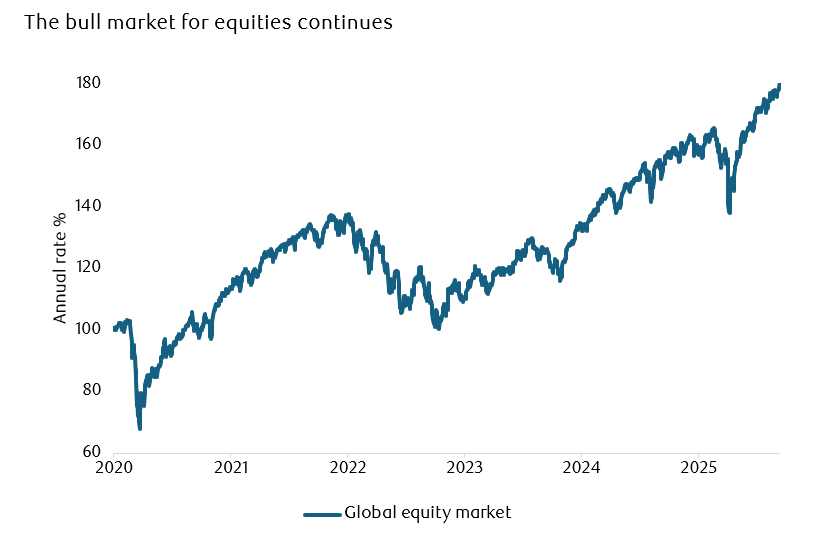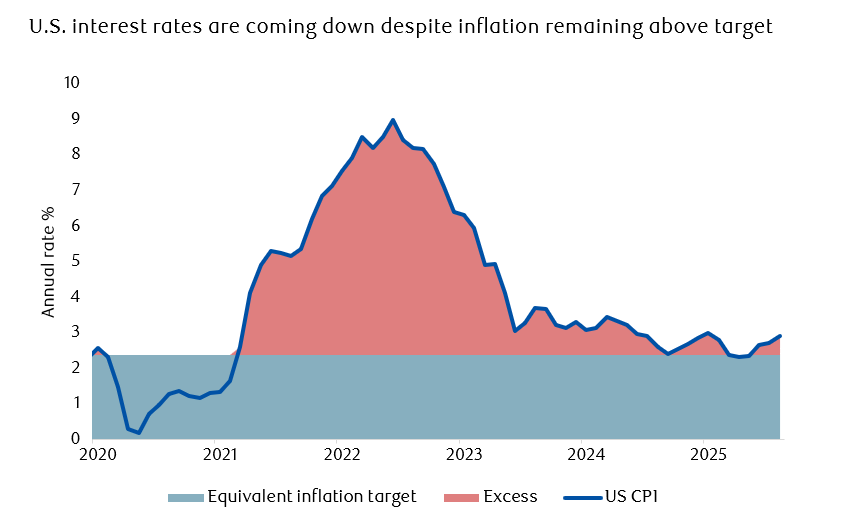U.S. interest rates expected to fall
Views & insightsGuy Foster, Chief Strategist, discusses the implications of a Federal Reserve interest rate cut. Plus, our Head of Market Analysis, Janet Mui, breaks down the latest U.S. inflation data.
Download Markets in a Minute PDF
Key highlights
- Stocks go up: Equities rallied as the first U.S. interest rate cut of 2025 – and the first of the second Trump administration – approaches.
- U.S. inflation: Latest figures put U.S. Consumer Price Index inflation at 2.9% in August, which indicates that Personal Consumption Expenditure figures will exceed the Federal Reserve’s target of 2% when released later this month.
- Europe holds rates: The European Central Bank held interest rates last week and the Bank of England is expected to follow suit on Thursday.
Stocks go up, rates come down

Source: LSEG Datastream
Stocks performed well last week, cheered on by the fact that the first U.S. interest rate cut of 2025 – or, perhaps more significantly, of the second Trump administration – is almost upon us.
Last week’s data removed any lingering doubt that rates will be cut this week, despite inflation seeming to move further above the Federal Reserve (the Fed)’s 2% target for Personal Consumption Expenditure (PCE) inflation. Last week’s Consumer Price Index data showed the rate of price growth accelerating to 2.9% per annum, indicating that the PCE will also have accelerated when it’s released later this month.

Source: LSEG Datastream
The Fed has a dual mandate to maintain price stability and employment. Inflation is expected to remain above target, but employment growth is slowing. The Fed is expected to prioritise heading off recession risk over the risks associated with inflation staying above target for a fourth consecutive year.
That judgement has been accompanied by an unusual amount of political pressure. President Trump’s nominee for governor of the Federal Reserve, Stephen Miran, was confirmed on Monday by the U.S. Senate. He will simultaneously retain his position as chair of the Council of Economic Advisers. Miran’s expected to take part in the Federal Open Market Committee’s meeting, which is being held over the next two days.
The increase in inflation was driven by a few factors. Cars, clothes and appliances all saw increases, suggesting the possible passthrough of tariffs. However, medical goods, toys and technology saw price falls. The data was not therefore conclusive on the speed with which tariffs are being passed through. If they are, there’s a convincing argument for the Fed to overlook tariffs as a source of inflation, and to consider them a one-off rather than a recurring source of price increases.
Will Europe see rate cuts?
Outside the U.S., the outlook for interest rates is steadier.
The European Central Bank (ECB) left rates on hold in its most recent meeting, and the Bank of England is expected to hold rates this week as well. For the ECB, the cuts made so far seem to have been successful in prompting an uptick in loan demand.
The central bank seems quite confident on the outlook for inflation and was able to upgrade estimates of current growth despite being hit by tariffs on exports to the U.S.
How’s the UK economy faring?
The UK still suffers from persistently high inflation but as we’re seeing signs of the labour market slowing, this should diminish over the coming months. Growth during July was estimated to have stagnated after a strong start to the year, and the housing market has slowed despite improving affordability. The obvious headwind to UK growth is concern over taxation as the Autumn Budget approaches.
In fact, UK borrowing costs are the highest in the G7 (which consists of Canada, France, Germany, Italy, Japan, the United Kingdom and the United States) and most developing markets. This is often seen as a sign that the markets are concerned about UK creditworthiness but in reality, the UK’s need to raise taxes is a function of its fiscal rules, designed to ensure that its creditworthiness stays intact.
The UK isn’t struggling to finance itself despite having some of the highest bond yields among developed markets. The average interest rate the UK is paying on its debt is 2.3%, well below current yields.
Bond yields reflect the cost of debt the government will pay on its next borrowing, but most UK debt was issued when interest rates were much lower. This means the UK is currently paying less for its debt than other countries, despite having higher bond yields.

Source: LSEG Datastream
However, that situation won’t last forever. As the UK’s need for new borrowing catches up with its current high yields, its borrowing costs will drift upwards, so there’s good reason to get the fiscal books in order.
That will be difficult as the government won power on promises to enhance public services while committing to not raise most major taxes.
The situation is much less acute than in France though. France’s current debt is more expensive, its budget shortfall is greater, it has no apparent plan to resolve the issue and its parliament is divided.
After the fall of François Bayrou and Michel Barnier’s governments, French President Emmanuel Macron has appointed Sébastien Lecornu as the new prime minister and tasked him with getting agreement on a budget to begin to restore France’s economic credibility.
Coming up
- UK interest rates: The Bank of England is expected to hold interest rates in Thursday’s meeting.
- The first cut: The Federal Reserve is expected to make the first interest rate cut of President Trump’s second term.
- Inflation: UK Chancellor Rachel Reeves will be hoping for some progress in bringing down inflation when figures are released on Wednesday.
The value of investments, and any income from them, can fall and you may get back less than you invested. Neither simulated nor actual past performance are reliable indicators of future performance. Investment values may increase or decrease as a result of currency fluctuations. Information is provided only as an example and is not a recommendation to pursue a particular strategy. Information contained in this document is believed to be reliable and accurate, but without further investigation cannot be warranted as to accuracy or completeness. Forecasts are not a reliable indicator of future performance. We or a connected person may have positions in or options on the securities mentioned herein or may buy, sell or offer to make a purchase or sale of such securities from time to time. For further information, please refer to our conflicts policy which is available on request or can be accessed via our website at www.brewin.co.uk.